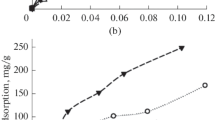Summary
The tyrosinases from Agaricus bisporus and Streptomyces eurythermus, laccases from Polyporus versicolor and Pleurotus ostreatus, and peroxidase from horseradish were strongly adsorbed on different bentonites and a clay-humus complex but less to on kaolinite and quartz. The adsorption was significantly dependent on the pH, reaching maxima in the range of the specific isoelectric points; it was less influenced by the valency and type of exchangeable cations. Most of the enzymes lost their activity when adsorbed on bentonite. The activity of desorbed enzymes was distinctly diminished when compared with free enzyme preparations. Conclusions from this behaviour were drawn as to the possible use of phenoloxidases as agents to transform phenolics in soil.
Similar content being viewed by others
References
Bartha R, Bordeleau LM (1969) Cell free peroxidases in soil. Soil Biol Biochem 1:139–143
Baumann R, Kocher HP (1976) Control of melanin formation in Streptomyces glaucescens. In: Arai T (ed) 2nd International Symposium on the Genetics of Industrial Microorganisms, Sheffield 1974. Academic Press, London, pp 535–551
Berry DF, Boyd SA (1985) Decontamination of soil through enhanced formation of bound residues. Environ Sci Technol 19:1132–1133
Bollag J-M, Leonowicz A (1984) Comparative studies of extracellular fungal laccases. Appl Environ Microbiol 48:849–854
Bollag J-M, Sjoblad RD, Minard RD (1977) Polymerization of phenolic intermediates of pesticides by a fungal enzyme. Experientia 33:1564–1566
Bollag J-M, Minard RD, Liu S-Y (1983) Cross-linkage between anilines and phenolic humus constituents. Environ Sci Technol 17:72–80
Bordeleau LM, Bartha R (1972) Biochemical transformation of herbicide-derived anilines: purification and characterization of causative enzymes. Can J Microbiol 18:1865–1871
Bradford MM (1976) A rapid and sensitive method for the quantification of microgram quantities of protein utilizing the principle of protein-dye binding. Anal Biochem 72:248–254
Chapman HD (1965) Cation-exchange-capacity. In: Black CA, Evans DD, White JL, Ensminger LE, Clark FE (eds) Methods of soil analysis, part 2. American Society of Agronomy, Madison, Wis., pp 891–901
Claus H (1983) Untersuchungen über die Tyrosinase bei Melaninbildenden Streptomyceten. Dissertation, TH Darmstadt, FRG
Claus H, Kutzner HJ (1985) Untersuchungen über die Tyrosinase von Streptomyceten. Landwirtsch Forch 38:48–54
Duguet JB, Dussert B, Bruchet A, Mallevialle J (1986) The potential use of ozone and a peroxidase for removal of aromatic compounds from water by polymerization. Ozone Sci Eng 8:247–260
Fåhreus G, Reinhammar B (1967) Large scale production and purification of laccase from cultures of the fungus Polyporus versicolor and some properties of laccase A. Acta Chem Scand 21:2367–2378
Filip Z, Preusse T (1985) Phenoloxidierende Enzyme-ihre Eigenschaften und Wirkungen im Boden. Pedobiologia 28:133–142
Fox AS, Burnett JB (1958) Kinetics of tyrosinase oxidation by crude tyrosinase preparation from Neurospora crassa. Proc Soc Exp Biol 98:110–114
Jerumanis J, Huynh N van, Devreux A (1976) Determination and properties of barley and malt polyphenoloxidase. J Am Soc Brew Chem 34:38–43
Kiss S, Dragan-Bularda M, Pasca D (1986) Activity and stability of enzyme molecules following their contact with clay mineral surfaces. Stud Univ Babes-Bolyai Biol 31:3–29
Lehninger AL (1978) Biochemistry, 2nd edn. Worth, New York, p 1104
Leonowicz A, Grzwnowicz K (1981) Quantitative estimation of laccase forms in some white-rot fungi using syringaldazine as a substrate. Enzyme Microbiol Technol 3:55–58
Mayaudon J, Sarkar JM (1975) Laccases de Polyporus versicolor dans le sol et la litiere. Soil Biol Biochem 7:31–34
Pazur JH, Aronson NN Jr (1972) Glycoenzymes: enzymes of glycoprotein structure. Adv Carbohydrate Chem Biochem 27:301–341
Robb DA, Gutteridge S (1981) Polypeptide composition of two fungal tyrosinases. Phytochemistry 20:1481–1485
Ruggiero P, Radogna VM (1984) Properties of laccase in humus-enzyme complexes. Soil Sci 138:74–87
Serban A, Nissenbaum A (1986) Humic acid association with peroxidase and catalase. Soil Biol Biochem 18:41–45
Shannon LM, Kay E, Lew JY (1966) Peroxidase isoenzymes from horseradish. I. Isolation and physical properties. J Biol Chem 241:2166–2172
Skujins JJ, Braal L, McLaren AD (1962) Characterization of phosphatase in a terrestrial soil sterilized with an electron beam. Enzymologia 25:125–133
Author information
Authors and Affiliations
Rights and permissions
About this article
Cite this article
Claus, H., Filip, Z. Behaviour of phenoloxidases in the presence of clays and other soil-related adsorbents. Appl Microbiol Biotechnol 28, 506–511 (1988). https://doi.org/10.1007/BF00268223
Received:
Accepted:
Issue Date:
DOI: https://doi.org/10.1007/BF00268223



